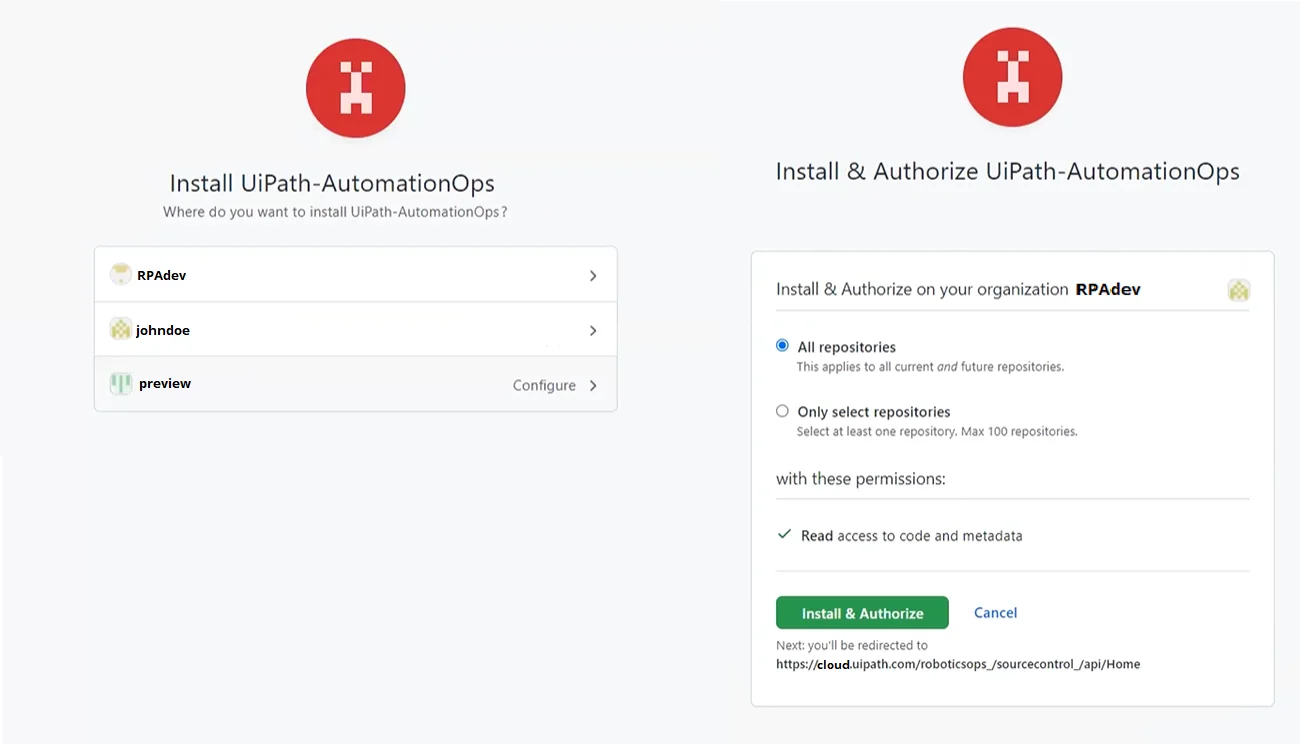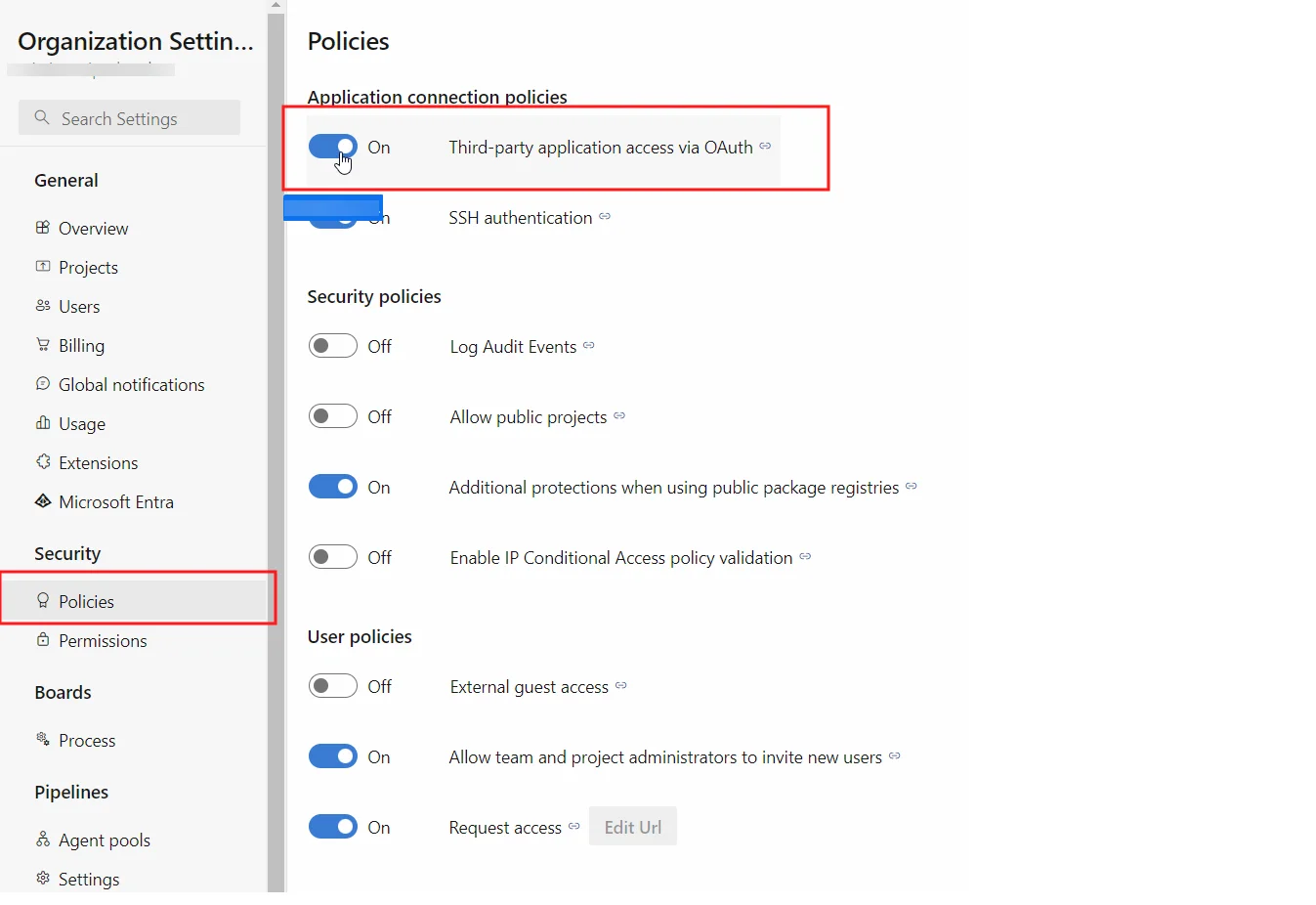- Getting Started
- Governance
- Source Control
- Source Control
- Troubleshooting
- CI/CD Pipelines
- Feed Management
- Logging

Automation Ops user guide
Source Control
Source control allows you to view updates to automation projects source code. This can be done using external providers if you are a regular user, in UiPath Cloud through Studio Web if you are an Organization Admin. Together with the Source Control feature available in Studio and StudioX, allows you to gain more control over code management.
Access to source control policies depends on the Automation Cloud offering you use. For details, refer to Automation Ops feature availability.
Prerequisites for external repositories
- A GitHub or Azure DevOps account with at least one organization and one repository.
- Rights to provide access for the UiPath-AutomationOps app on the repository. You must be either the GitHub organization administrator or the administrator of at least one repository. For Azure, the repositories the user has access to, will be connected.
The Azure Repos integration is currently in preview, which means certain functionalities might not be available.
Configuration
Automation Ops™ needs to connect to the GitHub or Azure organization to manage information. This is done by installing the UiPath-AutomationOps app on the GitHub or Azure side. A step-by-step guide is also available in the user interface.
Step 1: Initiate the connection from Automation Ops™
Access Automation Ops™, then select Source Control, then select on Connect to GitHub or Connect to Azure.

Step 2.a: Install and authorize the Automation Ops™ app for GitHub
When choosing to connect to GitHub, you are redirected to GitHub to select the organization and repositories you want Automation Ops™ to have access to.
If your GitHub Organization uses SSO login, you first need to sign in to GitHub. Next you have to install the GitHub app via Source Control by taking the following actions:
- Enterprise Managed Users - need to log in to GitHub through their IdP.
- Users can set up an SSO login session at:
https://github.com/orgs/<OrganizationName>/sso

Depending on your choice, the repositories presented in the following table appear in Automation Ops™ - Source Control:
| GitHub Role | Selection | Outcome |
|---|---|---|
| GitHub Organization administrator | All repositories | All public and private repositories. |
| GitHub Organization administrator | Only select repositories | Only the selected repositories appear (not all the public ones by default). |
| Repository administrator only | Only select repositories | You can only select from the repositories you administrate. |
The GitHub repository list can always be updated at a later time.
When connecting Automation Ops™ - Source Control to GitHub, you are prompted to grant the necessary permissions to fully use Source Control and Pipelines. The required permissions are:
- Read access to code and metadata
- Read and Write access to repository webhooks
- The connection to GitHub requires GitHub admin authentication, meaning that the user who initiates the connection from Automation Ops™ - Source Control must also be a GitHub organization administrator.
- Authentication via API keys or PAT tokens is not supported. A GitHub Organization Admin must log in through GitHub OAuth to set up the connection. If the Automation Ops user is not a GitHub Org Admin, a common workaround is to temporarily assign the Automation Ops Admin role to a GitHub Org Admin, allow them to complete the setup, and then revoke the role afterward.
- If you choose to manually select the repositories, you also need to explicitly select the public ones as there is no implicit selection for them.
- Automation Ops - Source Control only syncs RPA projects on the default branch of each repository.
If you need to connect to another GitHub organization or select different repositories, select the needed repositories from GitHub and resync the connection in Source Control.
You can remove the exisiting connection from the Connection settings menu > Remove.
When removing the connection in UiPath, the app installed on the GitHub side is also removed.

Step 2.b: Install and authorize the Automation Ops™ app for Azure Repos
When choosing to connect to Azure, you are redirected to Azure to provide the credentials and confirm you allow UiPath to read the repositories you have access to.
It's recommended to create and use a separate service account for providing access to the UiPath App on the Azure side. This is because the access is granted on behalf of the user account, meaning that if a user is part of multiple OAuth-enabled Azure organizations, they will all be reflected in Automation Ops™.
To sync your projects, you must enable the Third-party application access via OAuth at your Azure Organization settings level. For this, you have to access the Policy tab under Security. Enabling the option must be done before the authorization to your Azure Repos account. If you have already established the authorization, you need to resync the connection.

If the user that allowed the connection to Azure is part of multiple organizations and you want to avoid the content from a specific repository to be displayed in Automation Ops™, you must make sure that 3rd party integrations are disabled on the Azure side for that organization.

Once you select Accept, you are redirected back to Automation Ops™ where the list of available projects is populated.
In order to create Azure Service Hooks, Edit subscriptions and View subscriptions permissions are needed for the service-account that authorizes the application. By default, only Project Administrators have these permissions. To grant other users these permissions, you can use the Azure CLI or the Azure Security REST API.
To remove the integration between UiPath Automation Ops™ and Azure Repos, you have to access the Authorization tab under User settings on the Azure side and delete the authorized app from there, afterwards, you can remove the integration from the Manage Connections tab in Automation Ops™ - Source Control.

Step 3: View the projects in Automation Ops™
After the application is authorized, you are redirected back to Automation Ops™ and the project list is populated.
For each project, you can notice the following fields based on the project metadata in your external repository:
- Project Name
- Short description
- Compatibility
- Type
- Repository
- Last modified
To get the latest updates from yor external repository, select the Sync button under the Manage connections button or from the Manage connections menu.
You can synchronize the project list whenever needed so you get the latest added projects. After the synchronization completes, the updated project list is available to all Source Control users.
After the initial synchronization, subsequent syncs will be faster since they are based on the differences from the last sync.

Depending on the size of your repository, it might take some time for all projects to be displayed in Automation Ops™ - Source Control.
Viewing the commit history for a project
When you access a project, you can check the commit history of the project, which contains a short description of the change, the name of the person who made the commit, and the timestamp.

You can create a pipeline using the New Pipeline button. You are redirected to the Creating the first pipeline flow from the Pipelines section. In this case, the information required to define the pipeline is already filled in based on the project from which the pipeline creation process was triggered.
On the Pipelines section, if you change the repository/organization and then reselect the initial one, the preconfigured pipeline settings will be cleared.
If no Pipeline Runtime Environment is available, instead of the New Pipeline button, a new option is displayed: Set-up your pipelines. This redirects you to Pipelines Configuration, from where you can set-up the running environment.
Viewing the details of a commit
Opening a commit allows you to view the files that are part of the project in more detail.
-
For workflow files, a Studio-like view is available.
-
For other file types, a content-view is displayed based on the file type.
-
Selecting Variables, Arguments, or Imports provides details on each of them.

Comparing commits
Files that have been modified by the last commit are highlighted in yellow. To check the changes, select the Compare with previous commit button.

In the compare window:
-
The older version of the file is on the left and the newer version of the file is on the right.
-
The file name and the commit identifiers that are compared are displayed on the upper left side.
-
On the upper right side, you can navigate through each modification and select the type of change you want to check.

Navigating inside workflow files
For complex workflows, you can use the navigation controls to change the view and navigate through the workflow. Selecting the activity opens the Properties panel while selecting it twice expands that specific activity.
You can go one level back from the activity using the breadcrumb menu at the top.
The following navigation controls are available:
-
Expand all: expands all sub-workflows in the current view.
-
Zoom out: decreases the workflow visual size.
-
Reset: returns the view to 100% width.
-
Zoom in: increases the workflow visual size.

- Prerequisites for external repositories
- Configuration
- Step 1: Initiate the connection from Automation Ops™
- Step 2.a: Install and authorize the Automation Ops™ app for GitHub
- Step 2.b: Install and authorize the Automation Ops™ app for Azure Repos
- Step 3: View the projects in Automation Ops™
- Viewing the commit history for a project
- Viewing the details of a commit
- Comparing commits
- Navigating inside workflow files